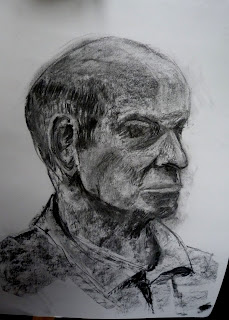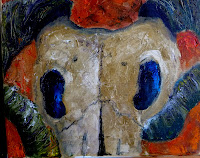I had also missed two session of James Lloyd's 'Drawing the Head' course at the Princes' Drawing School. I was assuming that what small steps I had made in my last session would all have washed away, but to my surprise, I was a little more confident and had clearly internalized those lessons about form through light and shade.Two portraits in one evening. Still not a strong likeness but a sense of form and depth. Satisfying, although no cause for complacency!
A record of the sometimes painful process of turning myself into something like a practicing artist after fifteen years of evening classes. A two year journey accompanied by my fellow travellers and the tutors on the City Lit Fine Art course 2010-12.
Monday, 14 November 2011
The trouble with 'end gaming'.
I have missed a couple of sessions of the CLFA course and despite some attempts to explore ideas whilst in Wales, I am still feeling that I am wallowing around somewhat without any clear sense of where I am going. I had a bracing tutorial with Tony Hull which was at once dispiriting and encouraging. I had made an effort in my sketchbook to structure my work so far and although he was polite about my various sketches it was clear that in his eyes they were not leading anywhere worthwhile. Certainly not in the direction I had tentatively explored while in Wales with three small paintings in acrylic: each trying to extend my sketches into colour:
When I got them out to show Tony there was a barely disguised sigh and a suggestion that I put them away as they weren't leading anywhere. He's probably right although I was not wholly unhappy with what they indicated. The middle more abstract painting included a sculpted piece of polymer clay which was another idea for a possible direction.
What did catch his eye were a series of very loose water colour studies that I had done the week before and which did, I agree, seem more promising:
These were water colour washes, with pen and ink and in some cases wax pastels. I genuinely hadn't a clue what I was trying to achieve and as a result, I suspect, actually created some images that had potential.
These caused us to talk about what I was trying to do. His main critique was that most of what I did was too governed by outcome. I was 'end gaming': trying to achieve something that I thought other people would
think looked good, rather than genuinely exploring. "The trouble with spending a lot of time trying to draw a bone is that all you can really say about it is: yes it looks like a bone (or not)." What we should be looking for are images that are more malleable: they suggest bone, but they suggest more and as a viewer you can take the image for a walk, it offers some alternative journeys. I found this very helpful. I certainly need to to find ways to let myself go and to eliminate, at this stage at least, a concern for what will look good in the sketch book or for achieving a satisfying effect that is actually nothing much more than just that. Helpful but not easy!
In subsequent conversations with my partner and son both suggested that a way forward was to find ways to put myself into the process. To find ways to connect my own lived experience with the art I am producing. There is a danger that it becomes a cliche: the lurch for the autobiographical. However, one direction this advice did suggest was to find ways to look at my own bones and as luck(!) would have it I recently dislocated my finger and had my hand X rayed. It is not a pretty sight, but it might give me a new avenue to explore: it not only connects with some lived experience but it also opens up another possibility (suggested by Ben) of exploring 'layers' of perception.
When I got them out to show Tony there was a barely disguised sigh and a suggestion that I put them away as they weren't leading anywhere. He's probably right although I was not wholly unhappy with what they indicated. The middle more abstract painting included a sculpted piece of polymer clay which was another idea for a possible direction.
What did catch his eye were a series of very loose water colour studies that I had done the week before and which did, I agree, seem more promising:
These were water colour washes, with pen and ink and in some cases wax pastels. I genuinely hadn't a clue what I was trying to achieve and as a result, I suspect, actually created some images that had potential.
These caused us to talk about what I was trying to do. His main critique was that most of what I did was too governed by outcome. I was 'end gaming': trying to achieve something that I thought other people would
think looked good, rather than genuinely exploring. "The trouble with spending a lot of time trying to draw a bone is that all you can really say about it is: yes it looks like a bone (or not)." What we should be looking for are images that are more malleable: they suggest bone, but they suggest more and as a viewer you can take the image for a walk, it offers some alternative journeys. I found this very helpful. I certainly need to to find ways to let myself go and to eliminate, at this stage at least, a concern for what will look good in the sketch book or for achieving a satisfying effect that is actually nothing much more than just that. Helpful but not easy!
In subsequent conversations with my partner and son both suggested that a way forward was to find ways to put myself into the process. To find ways to connect my own lived experience with the art I am producing. There is a danger that it becomes a cliche: the lurch for the autobiographical. However, one direction this advice did suggest was to find ways to look at my own bones and as luck(!) would have it I recently dislocated my finger and had my hand X rayed. It is not a pretty sight, but it might give me a new avenue to explore: it not only connects with some lived experience but it also opens up another possibility (suggested by Ben) of exploring 'layers' of perception.
Subscribe to:
Comments (Atom)







